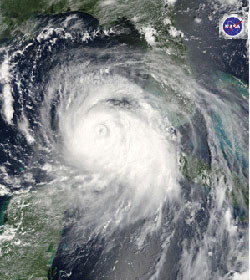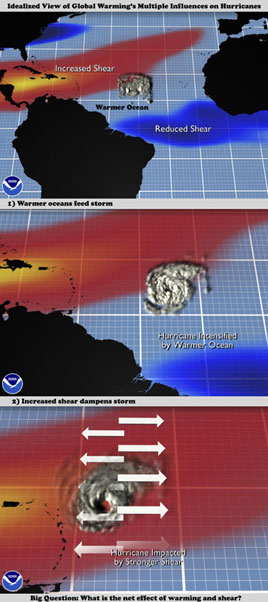Wind shear could reduce future hurricane activity
Wind shear could reduce future hurricane activity
Rhett A. Butler, mongabay.com
April 17, 2007
The debate over the impact of global warming on hurricane intensity rages on with a new study published April 18 in Geophysical Research Letters.
The research, conducted by Gabriel A. Vecchi of the National Oceanic and Atmospheric Administration (NOAA) and Brian J. Soden of the University of Miami, suggests that an increase in vertical wind shear in the tropical Atlantic and East Pacific Oceans could inhibit the formation and intensification of hurricanes. The authors note that increased vertical wind shear has historically been associated with “reduced hurricane activity and intensity.”
The results, based on complex climate model simulations for the effects of climate change in the years 2001-2020 and 2081-2100, counter other studies that suggest warmer sea temperatures will spawn ever stronger storms.

Hurricane Katrina. Courtesy of NASA |
“Wind shear is one of the dominant controls of hurricane activity, and the models project substantial increases in the Atlantic,” said Gabriel Vecchi, lead author of the paper and a research oceanographer at NOAA’s Geophysical Fluid Dynamics Laboratory in Princeton, N.J.. “Based on historical relationships, the impact of the projected shear change could be comparable in magnitude as that of the warming oceans—with the opposite effect.”
Reviewing results from 18 different models, the researchers project a “robust increase in wind shear over the tropical Atlantic and East Pacific attributable to global warming.” (Yes, the government scientist used the term “global warming”)
“The models send a fairly clear message that we can’t dismiss vertical wind shear as we look at the long-term effect of global warming on hurricanes,” Vecchi said. “This doesn’t settle the issue. It’s one piece of the puzzle that will contribute to what is an incredibly active field of research.”

Global warming’s multiple influences on hurricanes. Courtesy of NOAA |
“This study does not, in any way, undermine the widespread consensus in the scientific community about the reality of global warming,” said co-author Brian Soden, an associate professor of meteorology and physical oceanography. “In fact, the shear changes are driven by global warming.”
Related articles
2007 hurricane season will be ‘very active’ but not due to global warming — 4/3/2007
Developing La Nina conditions, not global warming, should make the 2007 Atlantic hurricane season ‘very active’ according to a top U.S. hurricane forecaster. William Gray of the Department of Atmospheric Science at Colorado State University said he expects 17 named storms this year, including 9 hurricanes. He says there is a 74 percent chance that a category 3, 4, or 5 hurricane will hit the U.S. coastline (the historic average for the past century is 52 percent) and a 49 percent chance that such a storm would hit the Gulf Coast of the United States (versus an average of 30 percent for the past century).
Global warming is causing stronger Atlantic hurricanes finds new study — 3/1/2007
Global warming is fueling stronger hurricanes according to a new Geophysical Research Letters study that revises that database of historic hurricanes. Previously the hurricane database was considered inconsistent for measuring the record of tropical storms since there have been significant improvements in the technology to measure storms since recording-keeping began. Before the development of weather satellites, scientists relied on ship reports and sailor logs to record storms. The advent of weather satellites in the 1960s improved monitoring, but records from newer technology have never been squared with older data. The new study normalizes the hurricane record since 1983.
Caves may reveal if global warming is causing stronger hurricanes — 1/29/2007
Scientists have shown that cave formations could help settle the contentious debate on whether hurricanes are strengthening in intensity due to global warming. Measuring oxygen isotope variation in stalagmites in Actun Tunichil Muknal cave in central Belize, a team of researchers have identified evidence of rainfall from 11 tropical cyclones over a 23 year period (1978-2001). The research — the study of ancient storms is called paleotempestology — could help create a record of hurricanes that would help researchers understand hurricane frequency and intensity. “Tropical cyclones (including hurricanes, tropical storms, typhoons, and cyclones) produce rainwater that is different from other summertime precipitation,” explained Amy Benoit Frappier, an assistant professor in the Department of Geology and Geophysics at Boston College and lead author of the study published in Geology. “Tropical cyclones produce isotopically light rainwater primarily because 1) their cloud tops are very high and cold, and 2) their humid air tends to prevent lighter water molecules from evaporating back out of the raindrop as they fall.”














